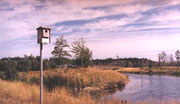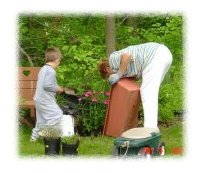Just my rantings . . .
 My soap box is sneaking out from under my desk again... I have some real concerns about our development which is supposed to be a 'Nature Conservancy'. I want to be a good neighbor and keep a positive attitude, but it's getting harder to keep quiet!!!
My soap box is sneaking out from under my desk again... I have some real concerns about our development which is supposed to be a 'Nature Conservancy'. I want to be a good neighbor and keep a positive attitude, but it's getting harder to keep quiet!!!I remained quiet when all the blackberry brambles & thistle stands were sprayed and removed from around the ponds and at the edges of the wetlands and woodland areas. Heaven knows the Black-eyed Susans were ugly with a fungus and needed to be cut down, but did they have to remove only the seed heads of all the Coneflowers before the birds had a chance at the seeds?
Not that I think that thistle is that attractive or necessary... but at the edge of the wetlands and other parts of the 'common areas' some could have been left standing for the wildlife. Did you know ... Goldfinches usually begin nesting in July or August, after most other songbirds have finished. The female builds a tightly woven nest of plant fiber lined with ‘thistledown’, and lays four to six eggs. Nests are always located near stands of thistle. Regurgitated thistle seeds are the primary food for nestling goldfinches. Although these birds may eat the seeds of many different plants, they prefer those of the composite flowers, such as thistles, dandelions, sun-flowers, coreopsis, and cosmos.
OK, I feel better now that I have a plan... I'll just have to plant more stuff (in my flower beds) that the birds can eat and share them with the neighbors for their 'Wildlife Garden'.


0 Comments:
Post a Comment
<< Home